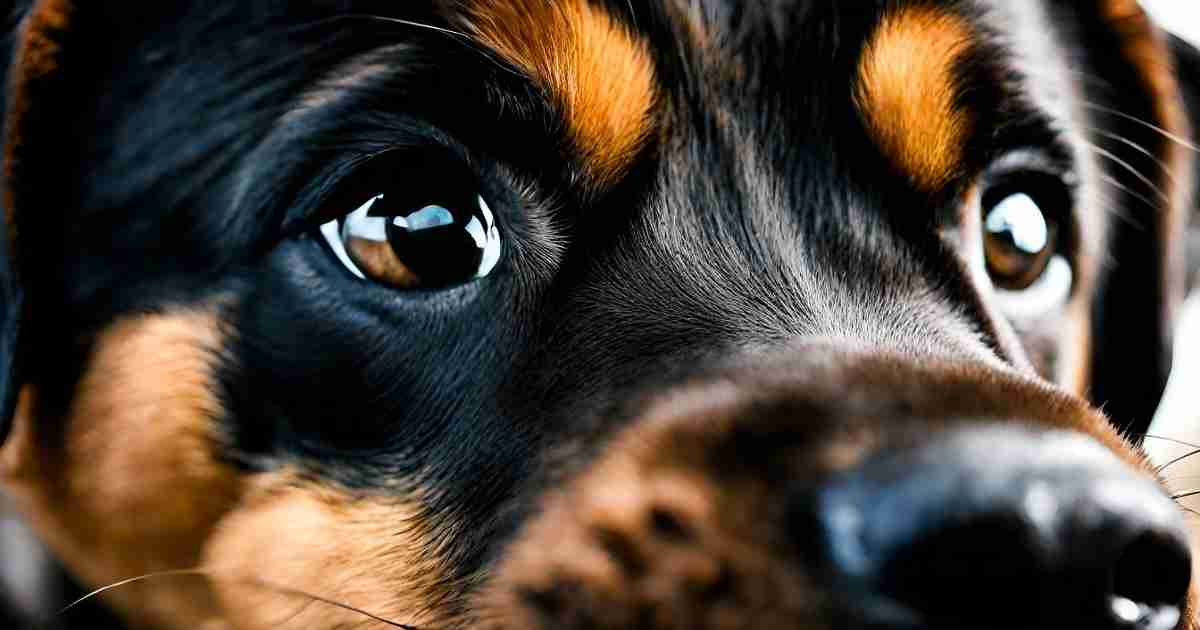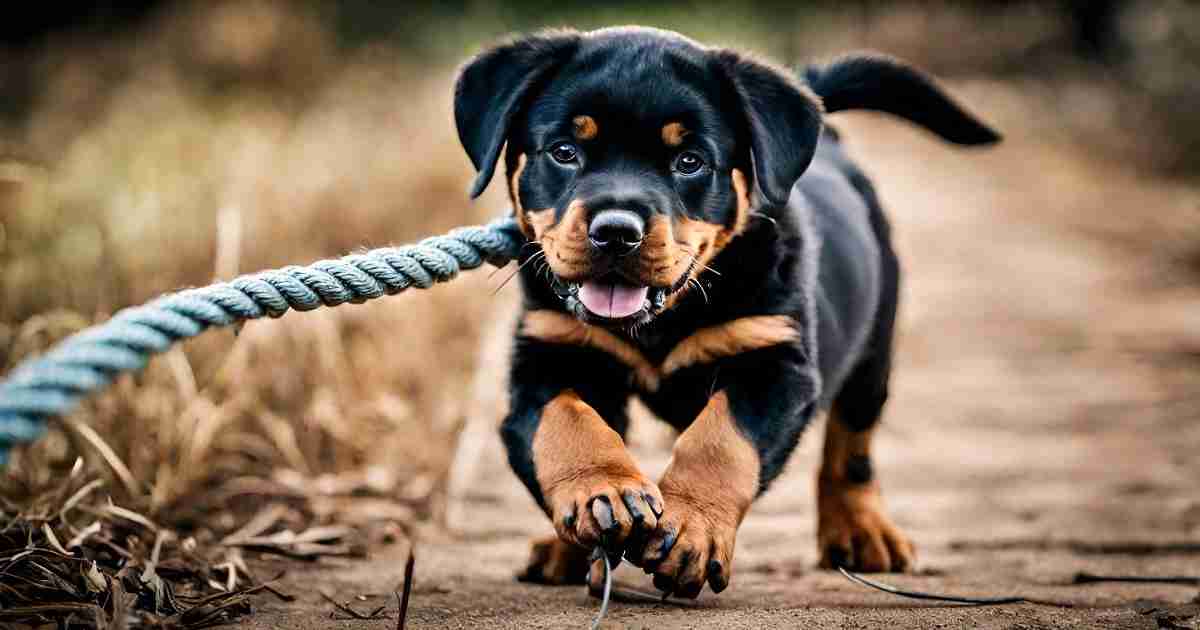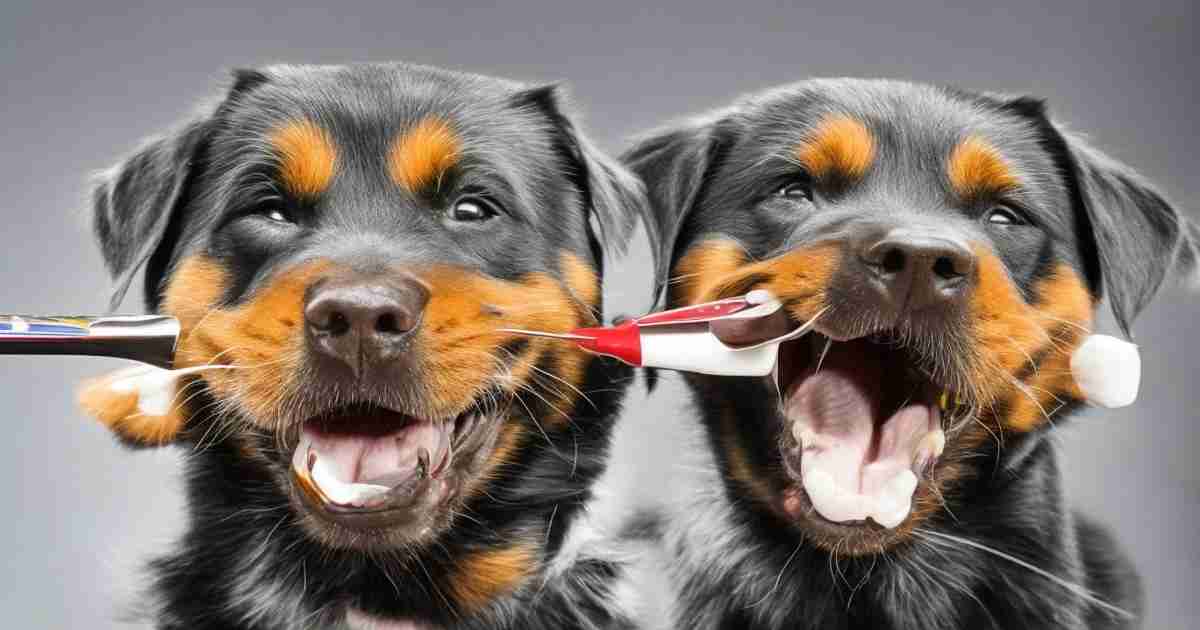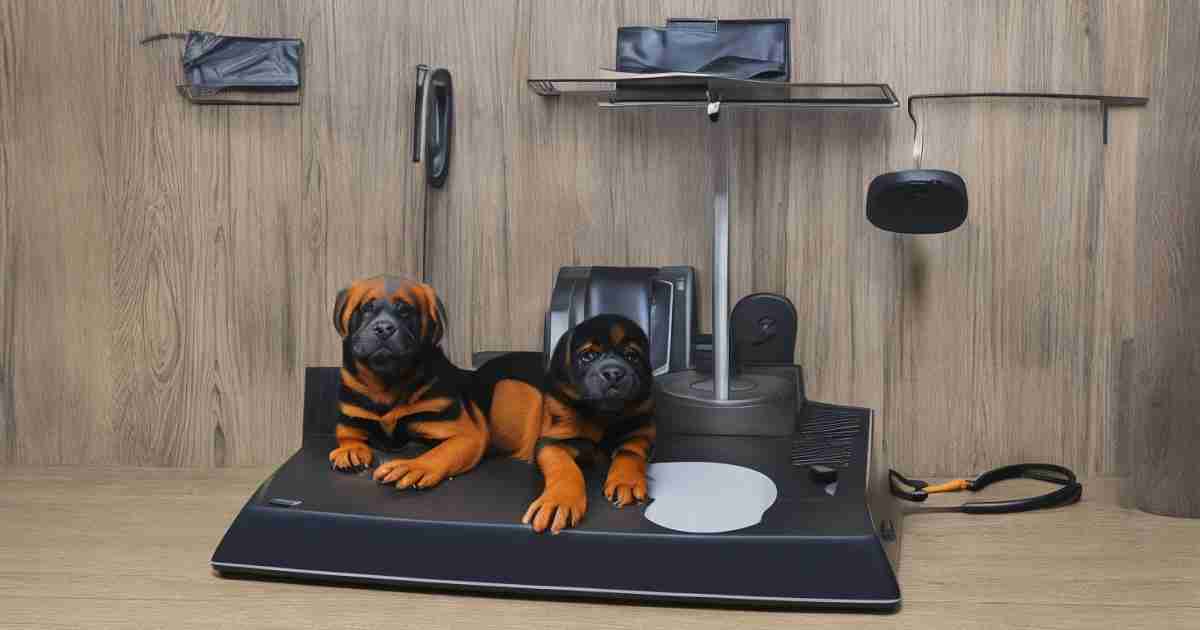Signs of a healthy Rottweiler puppy provide important clues about your pup’s well-being during these critical growing months.
Catching problems early maximizes the quality of life for your beloved companion. From shiny coats to energetic play, several key indicators across appearance, behavior, and development distinguish thriving Rottweiler puppies from those needing veterinary care.
Monitoring these health markers helps set your puppy up for a long, happy life ahead. This article will explore what to look for in your Rottweiler’s physical characteristics, interactions, activity levels, and more to ensure they’re growing into a healthy, well-adjusted dog.
Physical Appearance
As a Rottweiler health professional, I always carefully assess a puppy’s physical appearance for signs of health and proper development.
When evaluating coat condition, I look for a glossy, smooth coat without bald patches or irritation, indicating good nutrition and grooming.
A dull, flaky coat may suggest thyroid issues or allergies requiring veterinary attention.
Examining body structure, I check that the puppy has good skeletal proportions for their age and breed.
For example, a healthy Rottweiler puppy should have a broad chest and straight, sturdy legs to support their large size. An undernourished pup may appear too lanky and thin.
Tracking weight and growth milestones is also important. I advise owners to keep an eye on the vet’s growth charts, watching for steady gains that follow the normal curves.
Sudden weight loss/gain or falling off the charts could reflect an underlying health problem needing investigation.
However, a healthy Rottweiler puppy gaining weight appropriately demonstrates proper calorie intake.
By monitoring these physical health markers, owners can catch any abnormalities early and address problems before they worsen.
My goal is to help each Rottweiler puppy grow into a thriving, robust adult dog. Please let me know if you have any other questions!
Behavior and Temperament of Healthy Rottweiler Puppy
When evaluating a Rottweiler puppy’s behavior and temperament, I look for several key indicators that provide insight into their mental and emotional health.
Assessing socialization skills, I want to see the puppy feeling comfortable around new people, animals, and environments.
A well-socialized healthy Rottweiler puppy should show curiosity rather than fear when encountering novel sights and sounds. Shyness or reactivity suggests more positive exposures are needed.
I also look for age-appropriate playfulness and curiosity. Healthy Rottweiler puppies have an inherent sense of adventure and lively interest in toys, games, and exploring their surroundings.
Lack of energy or engagement may reflect an underlying health problem.
Evaluating temperament, I prefer to meet both parents when possible to get a sense of the puppy’s genetics.
A healthy Rottweiler puppy should demonstrate an easygoing attitude without major aggression or anxiety issues. If negative behaviors emerge, early intervention and training are key.
By regularly assessing these behavioral markers in Rottweiler puppies, owners can support proper socialization and identify any problem areas needing attention right away.
My goal is always to set up each puppy for behavioral success as they mature. Let me know if you have any other questions!
Dietary Indicators
As a Rottweiler health professional, I keep a close eye on puppies’ dietary indicators to ensure they’re receiving proper nutrition to thrive.
When evaluating eating habits, I look for a hearty appetite and eagerness to eat full meals.
A disinterest in food or treats can signal an underlying health issue in a puppy. Monitoring leftovers can identify foods a picky pup doesn’t like.
Tracking growth and weight gain against established charts provides key insights. A healthy Rottweiler puppy should gain weight steadily in line with the normal curves.
Sudden changes or veering off the charts warrant further veterinary investigation.
I also advise owners on nutrition essentials for each stage of development. High-quality puppy food supports bone/muscle growth in younger pups.
As they mature, transitioning to adult dog food prevents excess weight gain. Supplementing with fish oil and glucosamine aids joint health.
By paying attention to these dietary signals, Rottweiler owners can provide the fuel a growing puppy needs to develop into a healthy, energetic companion. Let me know if you have any other puppy nutrition questions!
Exercise and Activity Levels
Evaluating a Rottweiler puppy’s energy and activity provides important clues about their physical health.
Playful energy is a key sign of well-being in a growing pup. I like to see healthy Rottweiler puppies eagerly running and tumbling during play sessions. Lethargy or low stamina can indicate illness.
Assessing exercise requirements, active breeds like Rottweilers need sufficient daily activity to stay fit and stimulated.
I advise monitoring a puppy’s exercise tolerance and slowly increasing walks and playtimes as they mature.
When performing a physical fitness assessment, I check for normal heart/breathing rates after exercise along with good muscle tone, flexibility, and mobility. Clumsiness, limping or abnormal vital signs warrant medical attention.
By regularly monitoring activity levels and fitness, Rottweiler owners can identify any issues early and make adjustments to keep their growing puppy physically healthy and happy. Please let me know if you have any other questions!
Veterinary Checkpoints
As a Rottweiler health professional, I highly recommend establishing a relationship with a trusted veterinarian to monitor your puppy’s development.
Regular veterinary visits allow for thorough physical exams, diagnostic testing if needed, and an expert set of eyes to catch problems early. Puppies should be seen every few weeks in the first year.
Keeping up with vaccination records is crucial to protect against dangerous diseases like parvo and distemper. Core vaccines and optional lifestyle vaccines should be discussed with your vet.
Implementing parasite prevention is also essential, using monthly heartworm/flea/tick medication prescribed by your veterinarian. Intestinal parasites can also develop and warrant regular fecal screening.
By partnering with a knowledgeable vet for routine care, Rottweiler owners have a key ally for keeping their puppies happy and healthy as they grow. Let me know if any other veterinary questions come up!
Dental Health
A puppy’s dental health impacts their overall wellbeing, so I advise monitoring key areas:
The teething process brings sore gums and chewing behaviors as baby teeth emerge around 3-6 months old. Providing chew toys helps soothe discomfort during this stage.
Dental care practices like brushing, dental treats/chews, and professional cleanings are important lifelong. Starting brushing early makes it routine.
Look for signs of oral health issues like red/swollen gums, yellow/brown buildup on teeth, or foul breath. These indicate infection or periodontal disease requiring veterinary dental care.
With vigilant dental oversight, Rottweiler owners can help their puppies develop strong, healthy teeth and gums. Let me know if any other dental questions come up! I’m always happy to help.
Skin and Coat Health
A Rottweiler’s skin and coat condition offers visual clues about their health:
Coat luster and texture should be glossy and smooth without dry flakes or patches. Dull, thinning coats can reflect nutritional deficiencies or thyroid disorders.
Skin condition should be clear without redness, irritation, or itching. Rashes, bumps or inflammation may indicate allergies or infections needing veterinary attention.
Common skin issues like mange, yeast infections, and environmental allergies are manageable if addressed promptly. I advise owners to contact their vet if abnormalities develop.
With diligent grooming and care, Rottweiler owners can maintain their puppy’s skin/coat health to reduce itching and infections. Let me know if you have any other dermatology questions!
Eyes, Ears, and Nose
A Rottweiler’s eyes, ears, and nose require regular checks to stay healthy:
Clear eyes and vision should be present without redness, discharge, or squinting, which can indicate infection or injury. Annual vet eye exams test vision too.
Ear hygiene is key, with weekly cleaning to remove debris and wax buildup. Red, inflamed ears may mean infection – prompt medication prevents complications.
The nose should be moist without chronic dryness or crusting, though some cracking is normal in cold weather. Nasal irritation warrants investigation.
By monitoring these sensitive areas, Rottweiler owners can catch problems early before they become costly issues.
Let me know if you have any other questions about caring for your pup’s eyes, ears, or nose!
Digestive System
A puppy’s digestive health impacts their comfort and nutrient absorption:
Regular bowel movements should be monitored – loose stools or constipation signal GI upset. Sudden diarrhea warrants prompt veterinary attention.
Supporting overall digestive wellness involves a quality diet, probiotics/prebiotics, and preventing food intolerance. Discuss needs with your vet.
Detecting digestive issues like bloat, colitis, or food allergies relies on owners watching for vomiting, diarrhea, gas, or abdominal pain. Seek veterinary guidance for signs.
By staying alert to changes in appetite, stools, and tummy troubles, Rottweiler owners can optimize their pup’s digestive function for improved health and growth. Let me know if any other stomach/bowel questions arise!
Joint and Muscle Health
As a large breed, monitoring a Rottweiler puppy’s musculoskeletal development is important:
Observing mobility lets owners watch for limping, stiffness, reluctance to play, or difficulty standing up – all signs of joint pain requiring veterinary evaluation.
Joint development can be supported with vet-recommended supplements to protect cartilage and prevent issues like hip dysplasia.
Muscle tone should be appropriate for the puppy’s age and activity level. Weakness or atrophy indicates the need for assessment.
With mindful oversight and early intervention when needed, Rottweiler owners can help their puppy’s joints and muscles stay functionally fit to match their active, growing bodies. Please reach out with any other questions!
Genetic Health Considerations
As an aficionado of our four-legged companions, I find myself immersed in the fascinating world of Rottweilers—those majestic, loyal beings that effortlessly steal our hearts.
Today, let’s delve into the genetic realm, where the health of our beloved Rotties is intricately woven into the fabric of their existence.
The Symphony of Breed-Specific Genetic Concerns
In the grand orchestration of canine genetics, Rottweiler boasts a unique melody. Picture this: each Rottweiler is like a musical note, contributing to the harmony of the breed’s genetic composition.
These marvelous creatures, with their robust physique and distinctive markings, carry a genetic heritage that demands our attention.
Now, let me lead you through a journey of understanding. Have you ever wondered about the intricacies of a Rottweiler’s genetic makeup?
It’s a tale written in DNA, and within those strands lie the blueprints for their physical traits, temperament, and, yes, vulnerabilities.
It’s akin to unraveling a mystery novel, where each chapter reveals a piece of the larger narrative.
Healthy rottweiler puppy—two simple words that hold the promise of a thriving, vibrant life.
As I navigate the labyrinth of genetic concerns, I can’t help but ponder: What makes a Rottweiler’s genetic code resilient? What markers define a puppy as robust and full of vitality?
Navigating the Genetic Terrain: Screening for Genetic Issues
In the quest to ensure the well-being of our furry friends, genetic screening emerges as a pivotal chapter.
It’s akin to a health check-up for their very essence—the blueprint that shapes their existence.
Imagine it as a preventative measure, a way to identify potential hiccups in the genetic symphony before they crescendo into health challenges.
As I guide you through this screening process, envision it as a meticulous examination of the script written in their DNA.
We’re detectives, searching for clues that may influence their future health. It’s not about predicting the unpredictable but rather understanding the nuances that contribute to a Rottweiler’s overall vitality.
In this pursuit, responsible breeders play a crucial role. They are the architects of genetic well-being, carefully selecting pairings that complement each other’s strengths and mitigate weaknesses.
It’s a delicate dance of genetics, where the goal is to produce not just any Rottweiler, but a healthy rottweiler puppy—one that embodies the essence of vigor and resilience.
Breeding Wisdom: Responsible Breeding Practices
Now, let’s talk about responsible breeding practices—the cornerstone of ensuring a legacy of vitality for our Rottweiler.
It’s more than just pairing two dogs; it’s a thoughtful consideration of their genetic compatibility. Think of it as matchmaking for the well-being of future generations.
In the world of Rottweiler genetics, responsible breeders are the custodians of a sacred trust.
They understand the gravity of their role, recognizing that each pairing shapes the destiny of the breed.
It’s not merely about adhering to standards; it’s a commitment to fostering a lineage of healthy rottweiler puppies.
So, my fellow Rottie enthusiasts, as we navigate the intricate tapestry of genetic health considerations, let’s embrace the responsibility that comes with our love for these incredible creatures.
Through understanding, screening, and responsible breeding practices, we hold the key to unlocking a future where every wag of a Rottweiler’s tail is a testament to genetic vitality.
Mental Stimulation
Ah, the enigmatic world of a Rottweiler’s mind—a labyrinth of intellect waiting to be explored.
As an aficionado of these majestic companions, I often find myself pondering the intricacies of their mental landscape.
Join me on this cerebral journey as we unravel the secrets of healthy rottweiler puppies and delve into the captivating realm of mental stimulation.
Cultivating Intellectual Brilliance
In the tapestry of Rottweiler care, fostering intellectual development is akin to nurturing a delicate bloom.
How does one unlock the potential of a Rottweiler’s mind? It’s a question that lingers, beckoning us to embark on a quest for cognitive excellence.
As I navigate the landscape of intellectual development, picture it as a garden of knowledge where each interaction is a seed planted.
The goal? To cultivate a flourishing mind, one that mirrors the vitality we seek in a healthy rottweiler puppy. But how does one sow the seeds of brilliance?
- Interactive Learning: Engaging a Rottweiler’s mind involves interactive learning experiences. Think of it as a captivating story—each lesson unfolds, stimulating their curiosity and igniting the flames of intellectual curiosity.
- Puzzle Play: Imagine introducing your Rottie to a puzzle, a cognitive challenge that sparks joy. It’s not just about solving a puzzle; it’s about the mental gymnastics involved—the thrill of discovery etched in each victorious moment.
Playful Pursuits: Engaging Activities for a Sharp Mind
Now, let’s dive into the pool of engaging activities that serve as mental springboards for our Rotties.
Picture it as a playground of cognition, where each activity contributes to the holistic development of their minds. After all, a sharp mind is the bedrock of a healthy rottweiler puppy.
- Hide and Seek: Have you ever played hide and seek with a Rottweiler? It’s a delightful game of wits, as they use their keen senses to track you down. The thrill of the hunt becomes a mental exercise, keeping their minds agile and alert.
- Sensory Exploration: Envision a sensory journey where your Rottweiler explores different textures, scents, and sounds. It’s not just play; it’s a sensory feast that enriches their understanding of the world, contributing to a well-rounded mental outlook.
Decoding Behavior: Detecting Anomalies for Mental Well-being
In the symphony of a Rottweiler’s behavior, anomalies can be the subtle notes that signal underlying concerns.
As I reflect on my experience as a Rottweiler healthcare professional, detecting behavioral irregularities is akin to deciphering a cryptic message.
- Subtle Cues: Our Rotties communicate through subtle cues. It could be a shift in demeanor, a change in play patterns, or even altered eating habits. These nuances, if observed keenly, can serve as windows into their mental well-being.
- Professional Guidance: If you ever find yourself puzzled by your Rottweiler’s behavior, seeking professional guidance is a prudent step. It’s not a sign of weakness; rather, it’s a commitment to ensuring the mental health of your furry companion.
So, my fellow Rottweiler enthusiasts, let’s embark on this intellectual odyssey, where the brilliance of our Rotties shines as brightly as their physical prowess.
Through interactive learning, engaging activities, and a vigilant eye for behavioral anomalies, we lay the foundation for a future where every Rottweiler’s mind is a beacon of cognitive vitality.
Signs of Distress or Discomfort
In the intricate ballet of Rottweiler care, tuning in to the subtle cues of our furry friends becomes an art—an intuitive skill that goes beyond mere observation.
Advocating for these incredible companions, I often find myself deciphering the unspoken language they communicate, especially when it comes to signals of distress or discomfort.
The Whispers of Pain: Recognizing Pain in Rottweiler
As a Rottweiler health care pro, I’ve grasped that our cherished companions are virtuosos at concealing pain.
They march forward, veiling their unease with stoic grace. So, how do we uncover the enigma of pain in a Rottweiler? It’s like cracking open a mysterious code.
- Decoding Body Language: The body spins a tale—an intricate narrative woven into subtle movements. I’ve learned to catch the nuances: a slight limp, a momentary hesitation in their stride, or a shift in posture. These are the hushed whispers of pain, silent signals beckoning our attention.
- Windows to the Soul: Ever locked eyes with a Rottweiler and sensed an unspoken plea? The eyes spill volumes, mirroring pain that words cannot encapsulate. It’s a language of vulnerability, and deciphering these expressions is crucial to identifying discomfort.
Behold the Symphony: Behavioral Changes as Communicators
Rottweiler, akin to maestros, composes a symphony of behaviors—a melody that morphs when discomfort creeps in.
As I’ve navigated the complexities of their behavioral repertoire, I’ve discerned that shifts in this symphony can subtly hint at underlying distress.
- Shifts in Appetite: Envision this: a Rottweiler, famed for its hearty appetite, suddenly snubbing meals. It’s a red flag, a subtle note in the behavioral symphony signaling potential discomfort.
- Social Withdrawal Drama: Rottweiler thrives on social connections, so a sudden retreat from interactions is a telltale sign that something’s awry. Witnessing these behavioral changes, I often ponder: What cryptic distress signals are they weaving through their social cues?
Swift Steps to Soothe: Immediate Action for Rottweiler Comfort
In the realm of Rottweiler care, swift action emerges as the linchpin for quelling discomfort and securing the well-being of our furry companions.
It’s a responsibility I hold close, understanding that prompt measures can be a game-changer.
- Consultation with the Pros: If I pick up on any distress signals, I initially seek professional counsel. It’s a collaborative dance—partnering with veterinary experts to untangle the silent language of our Rotties.
- Comfort in Actions: Whether it’s a snug bed, a tender massage, or a reassuring touch, offering comfort measures is a tangible way to address immediate distress. It’s like extending a supportive hand, letting our Rottweilers know we’re in sync with their needs.
So, fellow Rottweiler enthusiasts, let’s embark on this expedition of interpreting silent signals.
Through astute observation, a reverence for behavioral symphonies, and swift, compassionate moves, we guarantee every Rottweiler in our care lives a life devoid of unnecessary discomfort.
After all, a Vibrant Rottweiler Pup is not merely physically robust but emotionally fulfilled—a harmonious blend of vitality and well-being.
Conclusion
In this captivating journey through the realms of Rottweiler care, I find myself at the crossroads of wisdom and compassion, reflecting on the tapestry woven by these remarkable companions. As we delve into the final act, let’s uncover the essence of healthy rottweiler puppies—a culmination of knowledge, early detection, and unwavering care.
Rediscovering Healthy Rottweiler Traits
In the grand finale, let’s take a moment to revisit the vibrant palette that paints the portrait of a healthy rottweiler puppy. It’s not just about robust physicality but a harmonious blend of traits that define their well-being:
- Vitality Beyond Physique: The vigor of a Rottweiler extends beyond mere physical strength. It’s a symphony of energy, enthusiasm, and the sheer joy of being.
- Intellectual Brilliance: Like unlocking the secrets of a treasure chest, nurturing their intellectual brilliance is key. Engaging activities, and interactive learning—are the building blocks of a mentally vibrant Rottweiler.
- Recognition of Distress Signals: The ability to decipher the whispers of pain and shifts in behavioral symphonies is a skill that sets the stage for timely intervention. A healthy rottweiler puppy is one whose distress is acknowledged and addressed promptly.
The Crucial Dance: Importance of Early Detection
As I stand on the precipice of conclusion, I can’t help but underscore the paramount importance of early detection. It’s akin to catching the first notes of a melodious tune before it transforms into a full-blown symphony. Early detection involves:
- Vigilant Observation: Cultivating a keen eye for subtle cues is the hallmark of early detection. It’s not just about seeing; it’s about understanding the silent language our Rottweiler communicates.
- Prompt Intervention: Early detection is a call to action. Whether it’s a shift in behavior or a hint of discomfort, swift steps are the linchpin for ensuring a trajectory toward a healthy rottweiler puppy.
Sustaining the Symphony: Ongoing Care and Attention
As we bid adieu to this exploration, let’s acknowledge that the journey doesn’t end—it evolves into a symphony of ongoing care and attention:
- Routine Check-ups: Regular health check-ups are the cornerstone of sustained well-being. It’s not just about addressing concerns but proactively ensuring the continued health of our Rottweilers.
- Nutritional Excellence: Like a well-composed melody, the right nutrition sustains their vitality. It’s a harmonious blend of quality diet and supplements tailored to their specific needs.
In conclusion, my fellow enthusiasts, we’ve unraveled the multifaceted layers of Rottweiler care, discovering the nuances that contribute to the making of a healthy rottweiler puppy.
As we continue this journey, let’s revel in the joy of companionship and the shared responsibility of ensuring our Rotties lead lives filled with vigor, intellect, and boundless well-being.
Frequently Asked Questions
How can you ensure that your Rottweiler remains mentally sharp?
- Keep their mind engaged by participating in activities that challenge them such as playing puzzles and exploring their senses.
What are some signs to watch out for that may indicate your Rottweiler is experiencing stress?
- Please pay attention to cues, like changes in their eating habits. If they start withdrawing socially.
Why is it crucial to detect health issues in Rottweilers?
- Detecting health issues early allows you to address them promptly ensuring a healthy Rottweiler puppy.
How frequently should you bring your Rottweiler for checkups?
- Make it a routine to schedule checkups once a year to maintain their overall well-being.
What effect does responsible breeding have on the health of Rottweilers?
Responsible breeding sets the foundation, for a lifetime of health by shaping their makeup.










1 thought on “Signs of a healthy Rottweiler puppy”